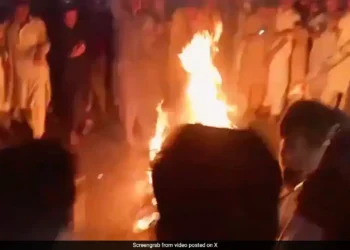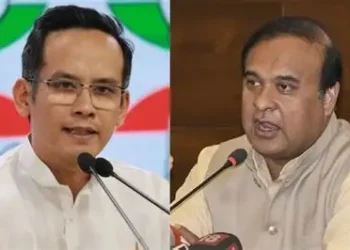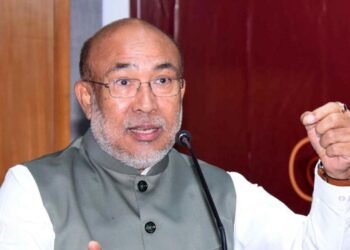From Uri to Poonch, artillery and mortar fire have left schools in ruins, homes flattened, and civilians scrambling for shelter amid rising casualties.
BY PC Bureau
Even as Pakistan launched a barrage of drones at Jammu on Friday night, the Line of Control (LoC) in Jammu and Kashmir witnessed relentless cross-border shelling and drone attacks, pushing India and Pakistan to the brink of a major conflict. The violence, triggered by India’s “Operation Sindoor” on May 6–7 targeting terrorist hideouts in Pakistan and Pakistan-occupied Kashmir (PoK), has escalated with Pakistan responding through artillery barrages and coordinated drone strikes. As of 21:15 IST, the situation remains volatile, with civilian casualties rising and widespread regional disruption intensifying.
As shelling continues unabated, the LoC remains a tinderbox. India’s decisive military response has checked Pakistan’s aggression, but the risk of escalation looms large in this nuclear-armed region. With civilian lives hanging in the balance and global powers urging restraint, the path to de-escalation hinges on urgent diplomatic efforts. Stay tuned for updates as this crisis unfolds.
#WATCH | J&K | Residents of Rajouri living along the LOC have started moving to safer areas after heavy cross-border shelling and attempted drone and missile attacks last night by Pakistan.
All drone and missile attacks were intercepted by India’s air defence system and foiled,… pic.twitter.com/XITK0CsejT
— ANI (@ANI) May 9, 2025
READ: Breaking: Loud explosion in Jammu amid Blackout and Siren
Fierce Clashes Along the LoC
Pakistani forces have unleashed heavy artillery, mortar fire, and small arms attacks across multiple LoC sectors, including Uri, Poonch, Rajouri, Kupwara, Baramulla, and Akhnoor, since May 7. The shelling has deliberately targeted civilian areas, causing widespread destruction. In Poonch, a shell struck near Christ School on May 7, killing two schoolchildren and injuring their parents, while a gurdwara and several homes were damaged. In Uri, heavy shelling resumed today, with a woman, Nargis Begum, killed and another, Hafeeza, injured yesterday when a vehicle was hit near Mohura.
Pakistan escalated its offensive with 300–400 drones targeting 36 locations in India, including military sites in Jammu, Udhampur, Samba, Akhnoor, and Pathankot, on May 8–9. Indian air defense systems, leveraging S-400 and L-70 guns, neutralized nearly all drones, averting major damage. In Samba, explosions lit up the night sky amid a blackout as drones were intercepted, with visuals deferred for security reasons. CCTV footage from Poonch captured the intensity of the shelling, fueling public outrage over attacks on civilian and religious sites.
Property was damaged after heavy firing and shelling by the Pakistan military overnight near the Line of Control (LoC) in the Uri sector of Baramulla district.
(📸: Umaisar Gull) pic.twitter.com/KOspuYvZEj
— Asia News Observer (@Ano4Asia) May 9, 2025
READ: Pakistan Minister Taps Madrassa Students for Defence
India’s Robust Response
The Indian Army has retaliated with precision, engaging Pakistani posts along the LoC. On May 8–9, India launched drone and missile strikes on Pakistani air defense systems in Lahore, Sialkot, Karachi, and Islamabad, crippling a key system in Lahore. In a significant escalation, Indian forces shot down a Pakistani F-16 fighter jet in Rajasthan on May 8 using a surface-to-air missile. The Border Security Force (BSF) also thwarted an infiltration attempt in Samba, killing seven terrorists and damaging Pakistan’s Dhandhar post. A video released today showed Indian troops destroying a Pakistani LoC post with an anti-tank guided missile, marking a bold response to the aggression.
Casualties and Devastation
The human toll is worrying. On the Indian side, at least 16 civilians and two soldiers, Lance Naik Dinesh Kumar Sharma and M. Murali Naik, have been killed since May 7, with over 59 injured, including two Central Reserve Police Force personnel. In Poonch and Rajouri, 12 civilians and one soldier died, with homes, schools, and a gurdwara reduced to rubble. Uri’s Salamabad village is a ghost town, with visuals showing collapsed homes and fires raging. Locals report children being shielded from shelling noise with cotton balls, and families left without food or shelter.
Pakistan has claimed that India’s Operation Sindoor resulted in 31 civilian deaths and 57 injuries, though India maintains that the casualty figures are much higher and primarily consisted of militants. Reports of damage to Pakistani civilian infrastructure, including mosques, remain unverified. India has accused Pakistan of fabricating these claims to deflect attention from its failed drone offensive..
Government Mobilizes, Region on Edge
Prime Minister Narendra Modi convened an urgent meeting with Army, Navy, and Air Force chiefs today to assess the crisis, followed by discussions with Rajasthan and Punjab chief ministers and armed forces veterans. The Ministry of External Affairs condemned Pakistan’s targeting of civilian sites, including a gurdwara and Christ School, accusing it of using civilian airliners as shields by keeping its airspace open during attacks. National Security Advisor Ajit Doval briefed counterparts in the US, UK, Saudi Arabia, and UAE, reaffirming India’s anti-terrorism resolve.
Northern India is reeling from the fallout. Jammu, Samba, Kathua, Rajouri, and Poonch schools are shut until May 10, with civilians evacuating border villages. Punjab is on high alert, with school closures and government personnel on standby. Rajasthan enforced blackouts in Barmer, Jaisalmer, and Jodhpur and banned drones and firecrackers. Gujarat followed suit, imposing similar restrictions. IndiGo canceled flights to Srinagar, Jammu, Leh, Amritsar, Chandigarh, Bikaner, Dharamshala, Rajkot, Jodhpur, and Kishangarh until May 10, with 25 airports, including Srinagar, closed and the Indian Air Force controlling Srinagar Airport.
Global Alarm, Disinformation War
The international community is sounding the alarm. The US, UK, UAE, China, Japan, and Nepal urged restraint, with President Donald Trump offering mediation and UN Secretary-General António Guterres warning of nuclear risks. Nepal condemned the Pahalgam attack, which killed a Nepali citizen, and expressed solidarity with India. The IMF, reviewing Pakistan’s funding, called for peace.
Both nations are locked in a disinformation battle. Pakistan’s claim of downing five Indian jets was debunked, with India attributing crashes to technical issues. A Pakistani video alleging the destruction of an Indian post was exposed as staged by the BSF. India accused Pakistan of fabricating an attack on the Neelam-Jhelam dam to cover its military setbacks.













